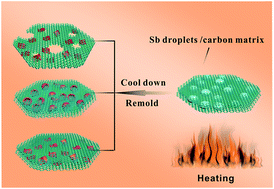In situ incorporation of nanostructured antimony in an N-doped carbon matrix for advanced sodium-ion batteries†
Abstract
Herein, a facile one-step and solvent-free pyrolysis method was developed to control the synthesis of nanostructured Sb embedded in an N-doped carbon matrix (Sb@GxNy-T, where T, Gx and Ny denote the annealing temperature and the mass (g) of glucose and NH4Cl used in the process, respectively). By adjusting these parameters, hybrid architectures can be in situ constructed, including hollow Sb embedded in holeless carbon matrixes (Sb@G0.25N0.5-950) and Sb nanoplates embedded in holey carbon matrixes (Sb@G0.25N0.25-950). Our findings suggest that the formation of diverse nanostructures closely relate to the sublimation and evaporation of Sb, and the structural remold of liquid Sb by surface tension. Benefitting from the unique structural features, these optimized electrodes show highly reversible sodium storage with high specific capacities and good cycling stability. More importantly, this strategy can be further extended to other material systems, such as Sn- and SnO2 nanodots embedded in a holey carbon matrix. This work presents a new scalable methodology to confine/remold nanostructured materials in a carbon matrix which allows for the future design of functional materials with tunable composition and architecture.



 Please wait while we load your content...
Please wait while we load your content...